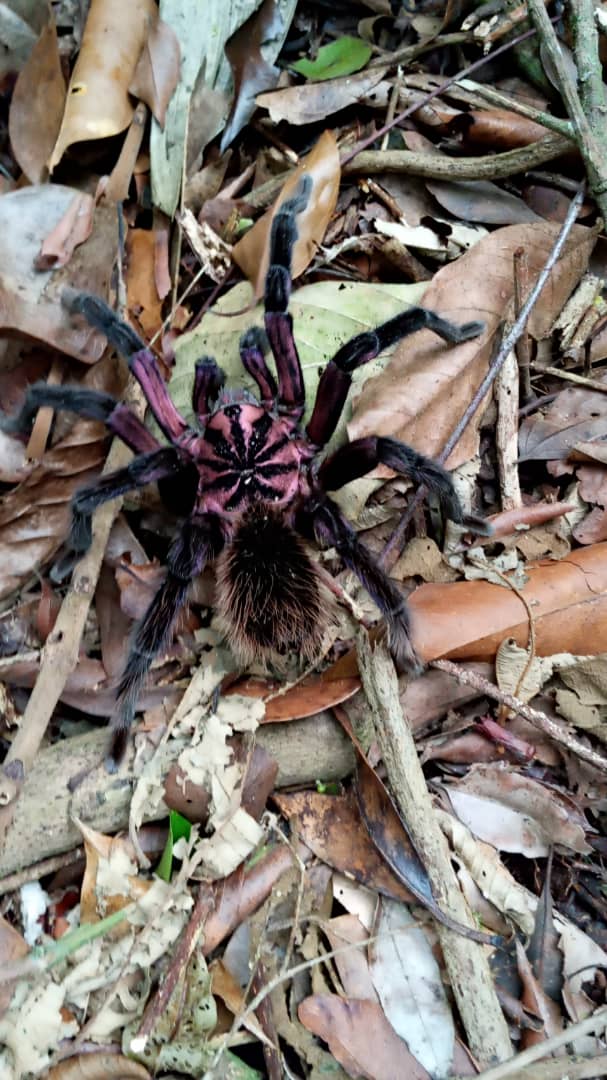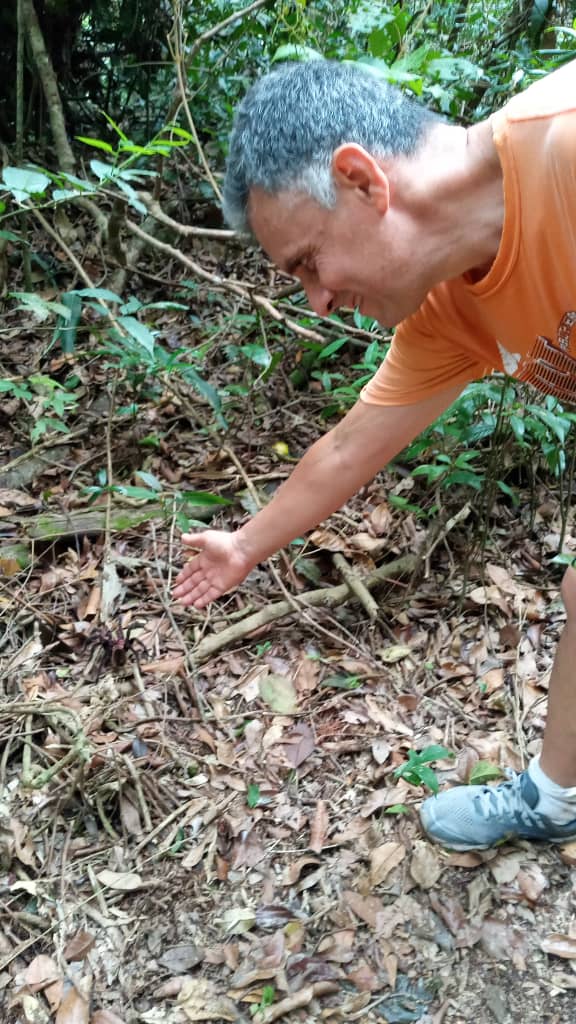Tarantula Rosada // Pink Tarantula (Xenesthis immanis)
¡Hola a todos en la comunidad! Espero que esten pasando un lindo día en el blog.
Hello everyone in the community! I hope you are having a nice day on the blog.

Hoy por la mañana conversando con mi padre por llamada, me comentó que se fue de excursión con un grupo de amigos a una montaña cerca de la ciudad (La zeta - San cristobal, Tachira - Venezuela) para variar la rutina que tiene.
Entre uno y otro cuento me dijo que se encontró con una especie de araña que nunca antes había visto, y se le hizo parecida a una tarántula (por la cantidad de vellosidades) pero rosada. Le pedí que me enviara fotos para investigar de qué araña se trataba, y para mi sorpresa, investigue que era una Tarántula Rosada.
Les hablare un poco de lo que encontré, pues al parecer, no hay mucha información de esta en internet.
This morning talking to my father by call, he told me that he went on an excursion with a group of friends to a mountain near the city (La zeta - San cristobal, Tachira - Venezuela) to vary his routine.
Between one story and another he told me that he found a species of spider that he had never seen before, and it seemed similar to a tarantula (due to the amount of villi) but pink. I asked him to send me photos to investigate what spider it was, and to my surprise, I investigated that it was a Pink Tarantula.
I will tell you a little about what I found, because apparently, there is not much information about this on the internet.
DESCRIPCIÓN
Se trata de una araña de la familia Theraphosidae, del género Xenesthis y su especie es conocida como Xenesthis immanis, estas tienen una longitud corporal entre los 9 - 10 cm, se dice que es de las mas grandes tarántulas en américa central y américa del sur.
DESCRIPTION
It is a spider of the family Theraphosidae, of the genus Xenesthis and its species is known as Xenesthis immanis, these have a body length between 9 - 10 cm, it is said to be one of the largest tarantulas in central america and south america.
APARIENCIA
-Las hembras adultas son de color negro sólido con un aterciopelado pelo castaño corto y largos pelos castaños rizados en el opistosoma.En el cefalotorax tiene un dibujo de color rosa.
-Los machos adultos son de colores brillantes,la coxa, trocánter,fémur y cefalotorax es de color rosa metalico.Las crias son muy grandes,de color uniforme marrón, teñido de negro.
APPEARANCE
-Adult females are solid black with velvety short brown hair and long curly brown hairs on the opistosoma. On the cephalothorax it has a pink pattern.
-Adult males are brightly colored, the coxa, trochanter, femur and cephalothorax are metallic pink. The offspring are very large, uniform brown in color, tinged with black.
CRÍAS
Crecen muy rápidamente y a partir del tercer estadio ya adquieren su color característico. El apareamiento suele ser bastante tranquilo.El capullo contiene aproximadamente 70 a 100 huevos.Los huevos y ninfas ya son muy grandes.
HATS
They grow very quickly and after the third stage they already acquire their characteristic color. Mating is usually quite calm. The cocoon contains about 70 to 100 eggs. The eggs and nymphs are already very large.
HÁBITAT
X.immanis habita las tierras bajas en zonas de selva tropical.
HABITAT
X.immanis inhabits the lowlands in tropical rainforest areas.
Esta tarántula como pueden observar posee unos colores hermosos y llamativos a la vista, su comportamiento es defensivo, un comportamiento bastante característico es que al sentirse amenazadas, levantan el abdomen con las patas traseras muy estiradas. Pueden lanzar sus pelos urticantes, pero estos, en el humano, se pueden comparar con la picadura de una hormiga, aunque, si están suficientemente cerca, pueden llegar a morder.
Según un estudio que se realizó en el año 1986 en la reserva natural de Tambopata (Perú), se constató que X.immanis comparte las madrigueras(simbiosis) con el anfibio Chiasmocleis ventrimaculata (rana de hojarasca del río Pastaza), la razón podría deberse a que le protege frente a hormigas y otros insectos indeseados,manteniendo así limpias las madrigueras.
This tarantula, as you can see, has beautiful and striking colors to the eye, its behavior is defensive, a quite characteristic behavior is that when they feel threatened, they raise the abdomen with their hind legs very stretched. They can throw their stinging hairs, but these, in the human, can be compared to the sting of an ant, although, if they are close enough, they can even bite.
According to a study carried out in 1986 in the Tambopata nature reserve (Peru), it was found that X. immanis shares burrows (symbiosis) with the amphibian Chiasmocleis ventrimaculata (leaf litter frog from the River Pastaza), the reason could be because it protects you against ants and other unwanted insects, thus keeping the burrows clean.

Espero que les haya gustado mi post, me pueden apoyar con su upvote y su comentario. Me pueden seguir en mi instagram personal Jhoansz o en Twitter Jhoansz

¡Mi publicación en Twitter! Me puedes apoyar con tu RT. #posh
https://twitter.com/Jhoansz/status/1261092829088100355
Congratulations @jhoancp! You have completed the following achievement on the Hive blockchain and have been rewarded with new badge(s) :
You can view your badges on your board and compare to others on the Ranking
If you no longer want to receive notifications, reply to this comment with the word
STOPDo not miss the last post from @hivebuzz:
Support the HiveBuzz project. Vote for our proposal!
Muy buena investigaciòn, estos insectos exòticos no se ven todos los dìas. Saludos desde Argentina!
¡Muchas gracias! Me entró demasiada curiosidad por lo bonita que es a simple vista. Igualmente saludos desde Venezuela
Thanks for your contribution to the STEMsocial community. Feel free to join us on discord to get to know the rest of us!
Please consider supporting our funding proposal, approving our witness (@stem.witness) or delegating to the @steemstem account (for some ROI).
Please consider using the STEMsocial app app and including @stemsocial as a beneficiary to get a stronger support.